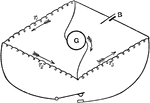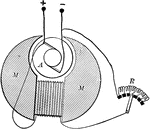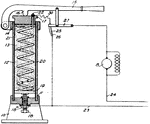Clipart tagged: ‘resistance’

Battery Resistance
An illustration of the assisting and opposing method used to measure battery resistance.

Buttress of Blocks
Uniting the theories of partial polygons of resistance and centres and lines of resistance, this buttress…

Velocities of Falling Bodies
"When a feather and a cent are dropped from the same height, the cent reaches jthe ground first. this…
Two Objects Falling in a Vacuum
"Remove the air from a high glass tube by means of an instrument called the air-pump... Then... drop…
!["Incandescence lamps operate essentially on the principle...[that] the current being sent through some substance that, because of its high resistance, becomes intensely heated and brilliantly incandescent. The only suitable substance known for such a resistance filament is carbon, which, carefully prepared and bent into a loop, is enclosed in a glass bulb from which the air is exhausted to prevent oxidation, i.e., combustion." -Avery 1895](https://etc.usf.edu/clipart/36000/36079/incand_36079_mth.gif)
Incandescence Lamp
"Incandescence lamps operate essentially on the principle...[that] the current being sent through some…
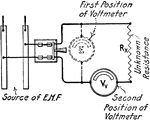
Measuring Insulation Resistance
"Illustrating method of measuring insulation resistance." —Croft 1920

Measure Armature Insulation Resistance
"Testing the insulation resistance of an armature." —Croft 1920
Measure Insulation Resistance of Motor
"Testing the insulation resistance of a motor or generator from its winding to ground." —Croft…

First Kind of Lever
"In straight levers of the first kind, the fulcrum is between the power and the resistance, as in fig…

Second Kind of Lever
"In the second order of levers, the resistance is between the fulcrum and the power; and, as before,…
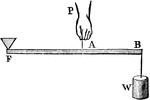
Third Kind of Lever
"In the third order of lever the power acts between the prop and the resistance, where also P : W ::…
!["[This illustration] shows the path of a stone thrown obliquely from the hand. The propelling force sends it in a straight line to A, and would take it on in the same direction to B, were it not that, as soon as its velocity becomes sufficiently diminished, gravity and the air's resistance give it a circular motion to C, and finally bring it to the earth at D." —Quackenbos 1859](https://etc.usf.edu/clipart/36300/36322/proj_mot_36322_mth.gif)
Projectile Motion of a Stone
"[This illustration] shows the path of a stone thrown obliquely from the hand. The propelling force…

Resistance Box
"When the brass plugs are inserted...the coils are short-circuited, i.e., practically, the whole of…
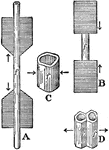
The Forms of Resistance
The four fundamental forms of resistance: A, to tension; B, to compression parallel to fiber; C, to…
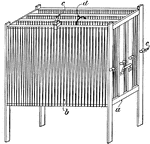
Rheostat
"Nichols Rheostat. a, wooden frame; b, tinned iron strip; c, stationary, and c', movable binding-posts;…

Telegraph Relay
"With a long main-line and many instruments in circuit, the resistance may be so great as to render…

Wheatstone Bridge
"The Wheatstone bridge is used as a way to measure resistance of a unknown resitors." -Avery 1895
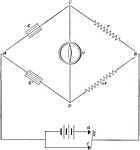
Wheatstone Bridge in Circuit
"The Wheatstone bridge is used as a way to measure resistance of a unknown resitors." -Avery 1895

Wheatstone Bridge with Resistors
"The Wheatstone bridge is used as a way to measure resistance of a unknown resitors." -Avery 1895

Wheatstones Bridge
"The best method for comparing resistances with great accuracy is the modification of Wheatstone's bridge…
